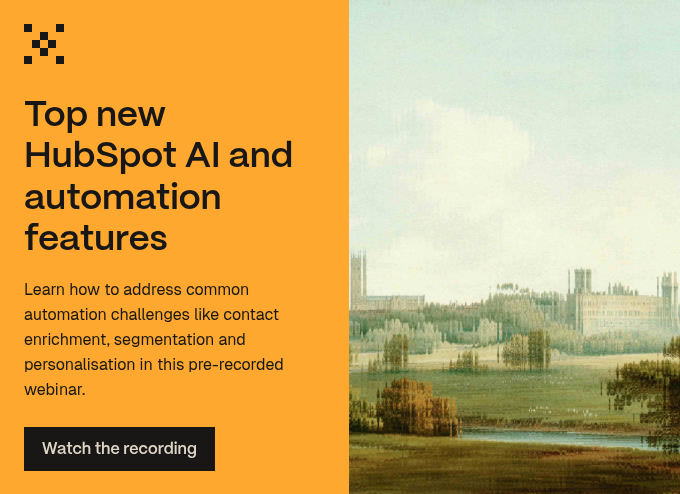This article shares the high-level takeaways from a webinar run by our CEO and Founder, Matthew Stibbe. To catch every pearl of wisdom, watch the full webinar here (gated content).
HubSpot has doubled down on AI and automation. The platform recently rolled out a raft of new AI-driven tools that can help businesses sharpen targeting, streamline processes and scale more effectively. But, as Matthew Stibbe (our CEO and Founder at Articulate) highlighted in a webinar, they’re not a silver bullet for marketing success.
Their effectiveness depends on your use cases, your execution and your appetite for experimentation. Some features are ready for prime time, others need careful handling and a few are still in ‘spooky valley’.
We’re expert HubSpot partners at Articulate, so we’ve explored the latest HubSpot AI and automation features in this article, as well as how you can use them and what to watch out for before you dive in headfirst.
New HubSpot AI and automation features
At the time of writing (October 2025), there are 11 new HubSpot AI and automation features we think every marketing leader should be considering, including brand data sources, engagement score and AI customer agent.
Brand data sources
AI is only as good as the data you feed it. If you want HubSpot features to produce useful, specific outputs (rather than bland generic ones) upload your ideal client profiles (ICPs), products, value proposition and solved pain points into the platform.
Think of it like onboarding a new salesperson: the better their briefing, the better their performance.

AI traffic sources
HubSpot now shows website traffic and leads from AI search engines like ChatGPT and Perplexity. Why does this matter? Because these clicks are increasingly valuable for brand awareness and lead generation. If someone leaves a zero-click AI answer to land on your site, they’re already motivated.
Our pro tip is to add AI traffic as a factor in your lead scoring as these visitors are more likely to convert.

Engagement score
Speaking of lead scoring, while the old way was fiddly, the new engagement score in HubSpot makes it easier. It buckets contacts into high, medium and low engagement.
- High engagement: lots of clicks, form fills and email opens.
- Medium engagement: lukewarm activity.
- Low engagement: cricket noises.
This clarity helps your teams prioritise outreach and tailor workflows accordingly. High-engagement leads can be routed to sales for human outreach, while medium-engagement leads might receive more targeted, automated nurturing through thought leadership and gated offers.

Data enrichment
Thanks to HubSpot’s acquisition of Clearbit, company enrichment is now baked into the platform. It’s particularly useful for firmographic data like industry, size and location.
A health warning, however: enrichment eats credits, so be selective. You’ll see better returns from enriching ‘recently engaged’ companies over your entire database. And weigh up your other options before you go all in. Other data providers like Apollo may still win for your business needs when it comes to contact-level data.

Buyer intent
HubSpot now flags buyer intent signals like funding rounds, leadership changes or technology research.
Instead of letting this intelligence languish in your CRM, you can turn it into action. Combine buyer intent signals with workflows to alert sales when a trigger occurs. If a target account secures new funding, that’s your cue to get calling.

AI Customer Agent
Perhaps the most exciting addition in HubSpot’s recent AI and automation cohort: the AI Customer Agent. You can upload documents, product pages and FAQs, and spin up an AI chatbot in under an hour that can answer a whole host of customer questions without manual programming.
If you deploy it in the right way, it can handle pre- or post-sale queries, allowing your team to switch their focus to higher-value conversations. Add a handover to live chat for complex issues, and you’ve got the best of both worlds.
Our advice: start with careful cohort testing to get the answers and experience right first before rolling out to all visitors.

Link HubSpot and ChatGPT
If you’re using ChatGPT Plus, you can now interrogate your HubSpot data inside ChatGPT. You could ask, for example, ‘What are our best-converting offers for Marketing Leaders?’
It’s a bit like having an analyst at your side. Just remember to treat the answers as directional insights instead of gospel truth.

More AI and automation features for efficiency
- Smart properties: AI can now populate structured CRM fields (like sector, headcount or competitor set) by scanning company websites. This is great for cutting down on dull, manual work, but it’s important to double-check the results. They’re powerful, but not 100 per cent accurate.
- Workflow AI: Workflows are also getting an AI boost, allowing you to automatically enrich profiles, categorise contacts or generate context for sales people. These real-time, dynamic and data-driven decisions take more labour-intensive tasks off your teams, freeing them up for human conversations.
- Data quality automation: The new data quality automation applies simple but effective fixes like capitalising names correctly. If you have access to this feature, switch it on. It’s a free, low-effort improvement.
- Meeting notetaker: HubSpot now offers its own native meeting transcription tool, replacing third-party apps like Fireflies. Notes are logged directly into the CRM, reducing admin and tool clutter.
Where to tread carefully (for now)
If you have time to tinker with implementation and catch errors before they become issues, there are even more features you can try. But we think the following might need a little longer to bake before they’re ready for the big time:
- Auto-creating content: There are still a few caveats to letting Breeze loose on your website copy and blog content, including the risk of inconsistent brand voice and biased, misleading information. We still recommend human captains and AI co-pilots.
- Content remix: One-click content repurposing might feel useful if you desperately need large volumes of social media posts in a matter of minutes, but we don’t think the brand risks outweigh the benefits (and neither do our clients).
- Prospecting agent: We’re not comfortable handing over our first interactions with prospective clients to an AI prospecting agent just yet. LinkedIn is already awash with complaints about AI sales spam.
- Anonymous visitor identification: When we tested the anonymous visitor identification, it only identified about one in 10,000 visitors on our website. So, still not quite there.
- Personalisation: The personalisation feature has some interesting potential for speeding up and scaling segmentation and content production. But, for now, it carries the same risks as content remix in terms of erroneous or off-brand copy.
Heading for HubSpot excellence
HubSpot’s latest AI and automation features give marketers and sales teams new ways to achieve more with less manual effort. What they don’t offer is a replacement for the immense value of human creativity and interactions, so continuing to invest in great people and partnerships is still essential to any sustainable growth strategy.
Watch the full HubSpot AI and automation webinar from our CEO and Founder, Matthew Stibbe, to get even more insights into these new HubSpot features. And if you want even more expert marketing advice, visit our webinar page for past talks on email marketing, websites, thought leadership and beyond.
 Posted by
Maddie Saunders
Posted by
Maddie Saunders
.jpg?width=1600&height=800&name=art-institute-of-chicago-srEIl5A91TQ-unsplash%20(1).jpg)


-1.jpg?width=400&height=250&name=birmingham-museums-trust-HEEvYhNzpEo-unsplash%20(1)-1.jpg)
-1.jpg?width=400&height=250&name=art-institute-of-chicago-wasoFWW8G1c-unsplash%20(1)-1.jpg)
-1.jpg?width=400&height=250&name=birmingham-museums-trust-ri8qLlGACc4-unsplash%20(1)-1.jpg)
